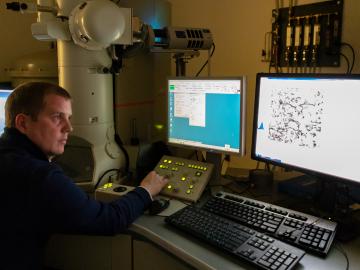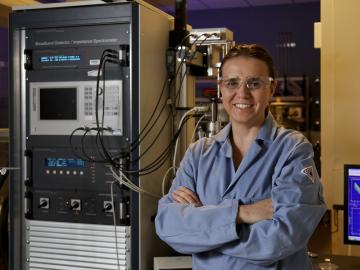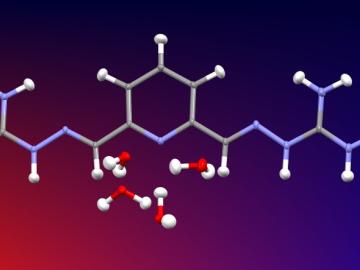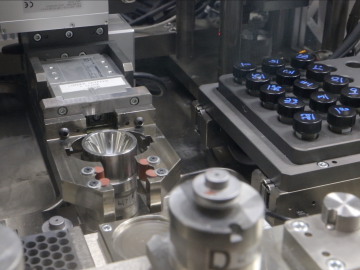
Filter News
Area of Research
- (-) Energy Science (70)
- (-) Materials (30)
- (-) Supercomputing (7)
- Advanced Manufacturing (6)
- Biology and Environment (35)
- Building Technologies (2)
- Computational Engineering (2)
- Computer Science (6)
- Energy Sciences (2)
- Fusion and Fission (6)
- Fusion Energy (8)
- Isotopes (1)
- Materials for Computing (5)
- Mathematics (1)
- National Security (6)
- Neutron Science (29)
- Nuclear Science and Technology (14)
- Nuclear Systems Modeling, Simulation and Validation (2)
News Type
News Topics
- (-) Advanced Reactors (2)
- (-) Artificial Intelligence (2)
- (-) Composites (9)
- (-) Energy Storage (34)
- (-) Microscopy (10)
- (-) Neutron Science (7)
- (-) Nuclear Energy (7)
- (-) Security (2)
- 3-D Printing/Advanced Manufacturing (36)
- Big Data (7)
- Bioenergy (5)
- Biology (4)
- Biomedical (7)
- Biotechnology (1)
- Buildings (19)
- Chemical Sciences (6)
- Clean Water (5)
- Computer Science (27)
- Coronavirus (9)
- Critical Materials (11)
- Cybersecurity (2)
- Environment (27)
- Exascale Computing (2)
- Frontier (2)
- Fusion (4)
- Grid (20)
- High-Performance Computing (6)
- Hydropower (2)
- Isotopes (2)
- Machine Learning (3)
- Materials (28)
- Materials Science (30)
- Mathematics (2)
- Mercury (2)
- Molten Salt (1)
- Nanotechnology (12)
- National Security (1)
- Physics (7)
- Polymers (10)
- Quantum Computing (5)
- Quantum Science (5)
- Simulation (3)
- Space Exploration (4)
- Statistics (1)
- Summit (7)
- Transportation (37)
Media Contacts

In a step toward advancing small modular nuclear reactor designs, scientists at Oak Ridge National Laboratory have run reactor simulations on ORNL supercomputer Summit with greater-than-expected computational efficiency.

Kevin Field at the Department of Energy’s Oak Ridge National Laboratory synthesizes and scrutinizes materials for nuclear power systems that must perform safely and efficiently over decades of irradiation.

Vera Bocharova at the Department of Energy’s Oak Ridge National Laboratory investigates the structure and dynamics of soft materials.

Researchers used neutron scattering at Oak Ridge National Laboratory’s Spallation Neutron Source to investigate the effectiveness of a novel crystallization method to capture carbon dioxide directly from the air.

Scientists have tested a novel heat-shielding graphite foam, originally created at Oak Ridge National Laboratory, at Germany’s Wendelstein 7-X stellarator with promising results for use in plasma-facing components of fusion reactors.

By automating the production of neptunium oxide-aluminum pellets, Oak Ridge National Laboratory scientists have eliminated a key bottleneck when producing plutonium-238 used by NASA to fuel deep space exploration.

Scientists at Oak Ridge National Laboratory and Hypres, a digital superconductor company, have tested a novel cryogenic, or low-temperature, memory cell circuit design that may boost memory storage while using less energy in future exascale and quantum computing applications.

Oak Ridge National Laboratory scientists studying fuel cells as a potential alternative to internal combustion engines used sophisticated electron microscopy to investigate the benefits of replacing high-cost platinum with a lower cost, carbon-nitrogen-manganese-based catalyst.

An Oak Ridge National Laboratory-led team used a scanning transmission electron microscope to selectively position single atoms below a crystal’s surface for the first time.

Sergei Kalinin of the Department of Energy’s Oak Ridge National Laboratory knows that seeing something is not the same as understanding it. As director of ORNL’s Institute for Functional Imaging of Materials, he convenes experts in microscopy and computing to gain scientific insigh...


